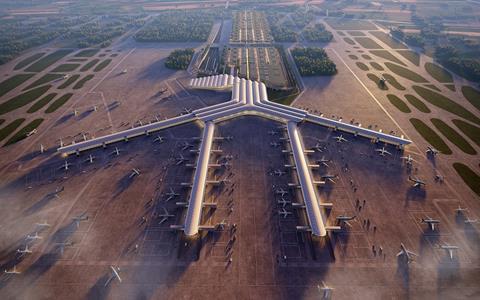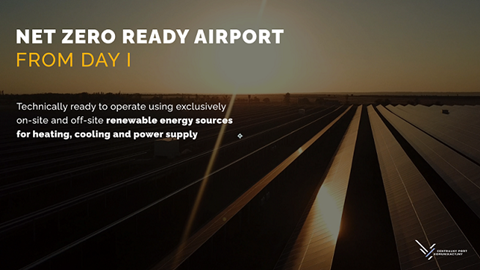In an era where the sustainability of transport sectors is not just an aspiration but a necessity, pressing concerns about the geopolitical implications of energy dependency are becoming increasingly evident. The global aviation industry, traditionally seen as one of the major consumers of energy, is at a crossroads.

Faced with decreasing resources and increasing pressure to achieve energy independence, nations around the world are facing the challenges of balancing energy security with the demands of economic growth. As a result, the focus is increasingly on large-scale facilities where the opportunities for significant energy savings and efficiency improvements are most tangible.
These facilities, such as the new Centralny Port Komunikacyjny (CPK) airport, represent examples of focal points for innovative energy strategies that harmonise both operational efficiency and environmental governance, responding to the urgent need to rethink energy production and consumption in the face of a changing global reality.
The CPK project seeks to combat climate change and includes energy-efficient measures, such as the use of renewable energy sources like solar energy, geothermal heating and cooling, and smart and highly efficient energy systems, to ensure the airport’s net zero vision once operational in 2028.
Moreover, water resources are also planned to be managed sustainably through rainwater harvesting and on-site treatment plants that reuse non-potable water for irrigation, as well as for flushing and process systems, including heating, cooling and ventilation.

Electrical systems
In line with the above, the electrical installations of the CPK airport will be designed to provide the future-proof and flexible state-of-the-art solutions required for the project, while considering cost effectiveness, efficiency, reliability, simplified installation, operation, maintenance, along with ensuring safety measures to guarantee the protection and safety of people as well as equipment and assets.
From an energy point of view, the circulatory system of the CPK infrastructure is based on a precisely designed, high-voltage power installation. Created with the dynamic needs of modern air transport in mind, this system will not only remain state-of-the-art, but also future-proof, balancing the requirements for cost-effectiveness, efficiency and reliability.
Ultimately, the power installation will be fully hybrid, allowing simplified operation and low maintenance costs. Furthermore, the greatest emphasis of the project is on ensuring the safety of the people and the equipment. CPK’s commitment to sustainability is demonstrated in the well-considered strategies related to optimising energy consumption etc.
Looking into the technical details, the estimated power load for this gigantic project will be in the 150-250 MW range during the peak phase.
To prevent unforeseen power outages, a centralised emergency system will be installed to ensure that safety and other core systems remain operational in the case of a power failure.
The power system will be supplied by two independent 400/110/15 kV and 110/110/15 kV sources. Therefore, the CPK’s power grid will guarantee uninterruptible power supply continuity and ensure 100% safety of all flight operations.
What really sets CPK apart is its commitment to combating climate change. Aiming to minimise its carbon footprint, CPK is committed to using sustainable energy, which is demonstrated by its plan to install photovoltaic (PV) systems. These panels, decorating green areas, for building roofs and even car park canopies, play a key role in generating green energy.
However, their deployment is a complicated process, where emitting or causing a beam of light to be emitted towards the aircraft may cause glare/blinding or the occurrence of a glare, which is a real safety risk for the aircraft, passengers and crew. Photovoltaic (PV) installations will be designed to be safe for aircraft pilots and air traffic controllers.

Cooling and Heating
In modern construction, HVAC (heating, ventilation and air conditioning) systems, despite their inconspicuous presence, significantly affect the energy balance of buildings. In addition to simple operational needs, these systems play a key role in ensuring human comfort in enclosed spaces.
This is why it is so important that HVAC systems are consistently analysed and optimised in order to play an important role among energy-saving initiatives.
Many large facilities, especially airports and sprawling ‘campuses’, such as the future CPK Airport City, face large HVAC requirements. The challenge is to establish efficient energy production while accommodating the various HVAC requirements of different assets.
District Energy Systems (DES) comes to the rescue here – a progressive approach that is gaining popularity worldwide. DES seamlessly addresses both the heating and cooling needs of facilities, harmonising the energy demand profiles and reducing the overall peak demand.
At CPK airport, the mechanisms for heating and cooling the buildings have been entrusted to the Ambient loop ‘5th generation’ energy system. This innovative approach departs significantly from traditional heating networks, favouring a complete transition to renewable and zero-carbon energy sources.
At the heart of this state-of-the-art system is a central water loop that is connected to each building, facilitating the transfer of energy between the building and central energy production hubs. The Ambient Loop is characterised by its scalability, with the possibility of expansion through the integration of additional loops.
The system performs well using any available low-grade heat source or heat sink – hot or cold, to maintain the temperature within the designated range.
The brilliance of the Ambient Loop system is captured in its foundational principles. It understands that the energy that is often expelled during heating or cooling can be reclaimed and repurposed.
Moreover, the energy produced by one facility at a certain time can be efficiently redirected and utilized by another at a different time. Furthermore, this versatile system welcomes a diverse range of energy sources, both traditional and renewable, such as chiller-based centers, geothermal reserves, and sewage recovery mechanisms, all working together to stabilize the net energy requirement.
Embracing the Ambient Loop district energy system not only curtails the environmental impact and carbon footprint characteristic of traditional HVAC systems but also significantly diminishes the dependency on fossil fuels, revolutionizing the paradigm of energy production and consumption.
















